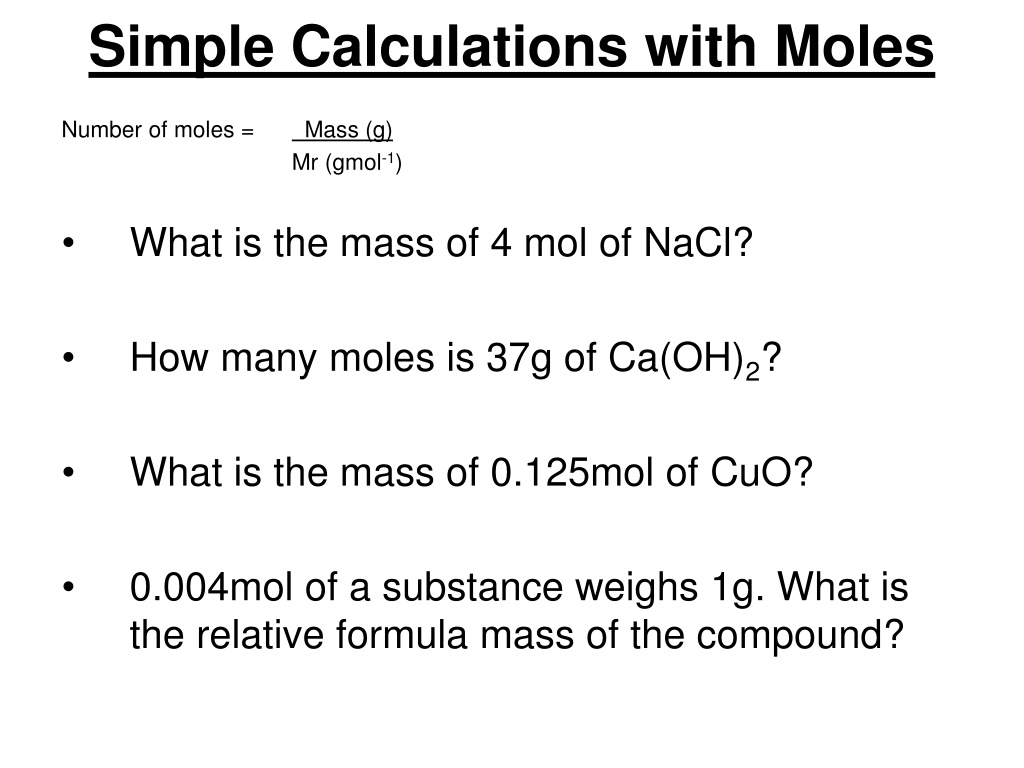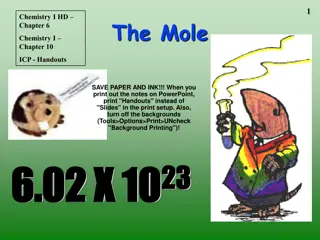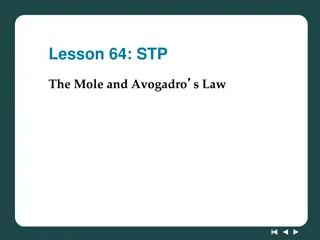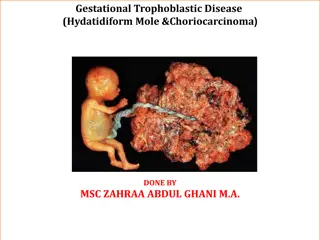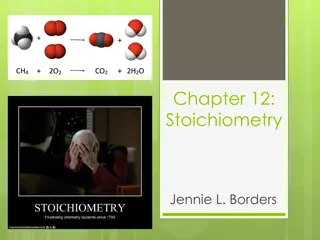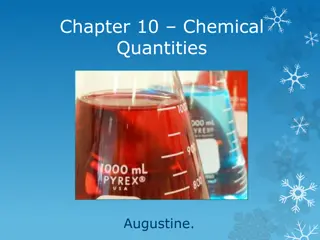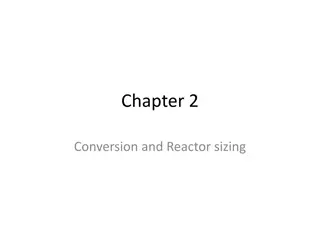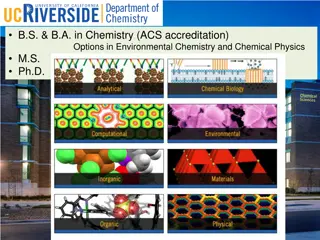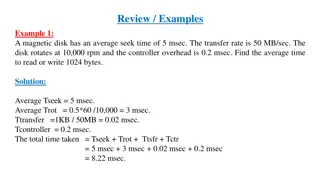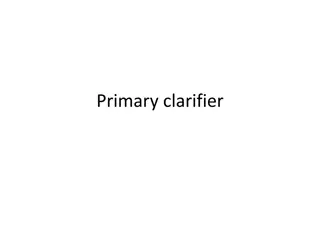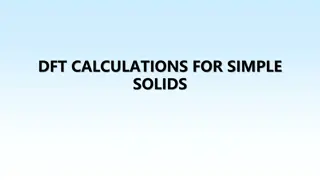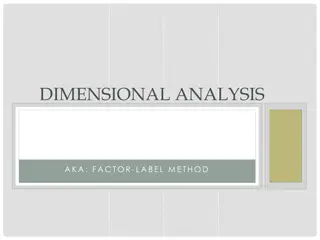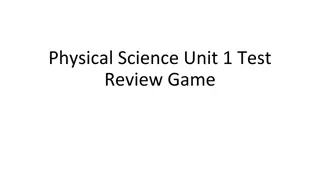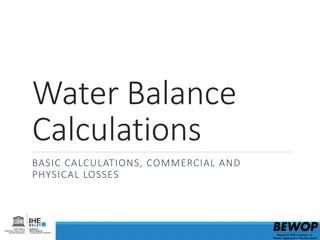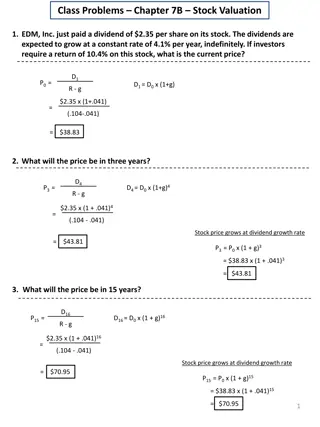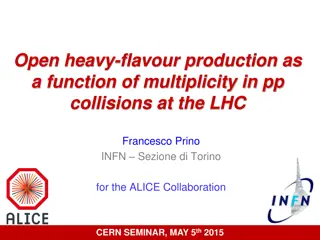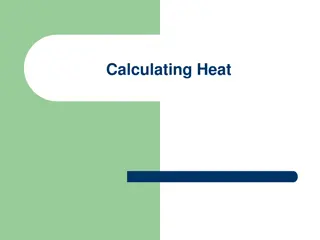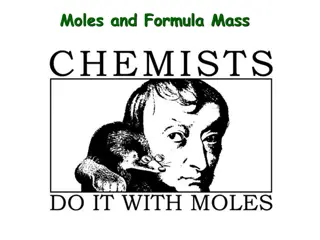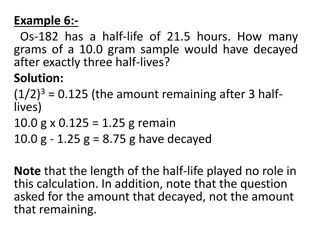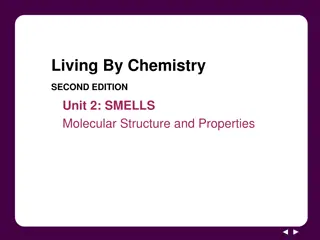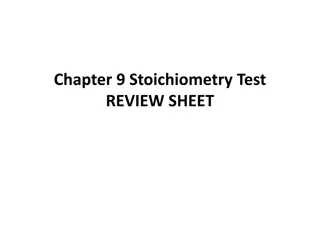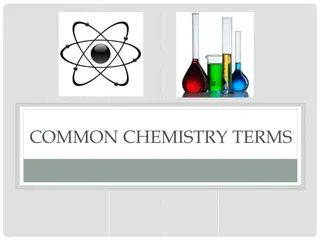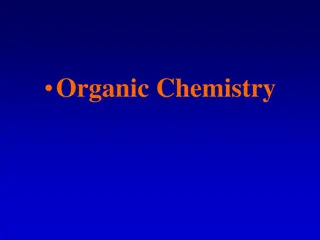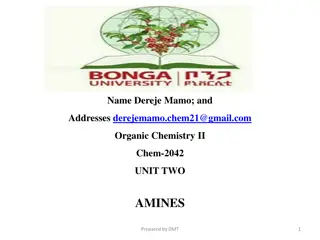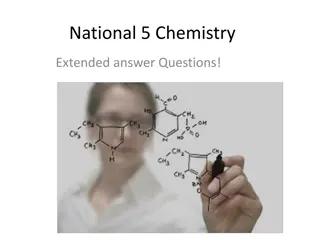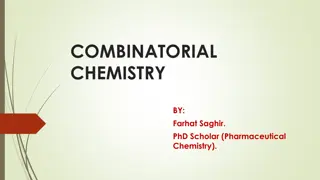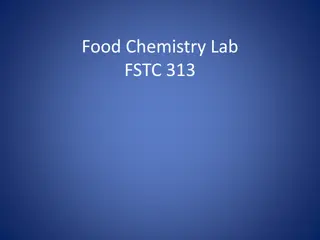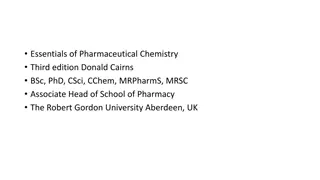Understanding Mole Calculations in Chemistry
Explore various mole calculations in chemistry such as determining mass from moles, moles from mass, and comparing particles in different substances. Learn how to calculate the mass of substances, the number of particles, and perform calculations using balanced equations. Dive into concepts like molar mass, Avogadro's number, and stoichiometry with practical examples and visual aids.
Download Presentation

Please find below an Image/Link to download the presentation.
The content on the website is provided AS IS for your information and personal use only. It may not be sold, licensed, or shared on other websites without obtaining consent from the author. Download presentation by click this link. If you encounter any issues during the download, it is possible that the publisher has removed the file from their server.
E N D
Presentation Transcript
Simple Calculations with Moles Number of moles = Mass (g) Mr (gmol-1) What is the mass of 4 mol of NaCl? How many moles is 37g of Ca(OH)2? What is the mass of 0.125mol of CuO? 0.004mol of a substance weighs 1g. What is the relative formula mass of the compound?
Moles 2. What mass of Mg contains the same number of Mg atoms, as there are molecules of CO2in 1000g of CO2?
Simple Calculations with Moles Number of moles = mass (g) mass of 1 mole (g) 1. How many water molecules are there in 1 drop of water? (Assume 1 drop = 0.05cm3and the density of water = 1 g cm-3 2. Seawater contains about 30g of ionic sodium chloride, Na+Cl-, in every 1000cm3of water. What volume of sea water contains 1020 ion pairs, Na+Cl-? (Na=23; Cl=35.5) 3. Which of the following contains the greatest number of stated particles? A. B. C. Molecules of hydrogen in 1g of hydrogen gas, H2. Atoms of helium in 1g of helium gas, He. Atoms of beryllium in 1g of beryllium, Be.
Simple Calculations with Moles Number of moles = mass (g) mass of 1 mole (g) 1. How many water molecules are there in 1 drop of water? (Assume 1 drop = 0.05cm3and the density of water = 1 g cm-3
Simple Calculations with Moles Number of moles = mass (g) mass of 1 mole (g) 2. Seawater contains about 30g of ionic sodium chloride, NaCl, in every 1000cm3of water. What volume of sea water contains 1020 moles pairs, NaCl? (Na=23; Cl=35.5)
Simple Calculations with Moles Number of moles = mass (g) mass of 1 mole (g) 3. Which of the following contains the greatest number of stated particles? Molecules of hydrogen in 1g of hydrogen gas, H2. Atoms of helium in 1g of helium gas, He. Atoms of beryllium in 1g of beryllium, Be. A. B. C.
Using moles and Balanced Equations If you write a formula for a substance in a calculation, it is often convenient to take that formula as meaning 1 mole of that substance. This enables you to attach a mass to it and therefore to work things out from it. What mass of calcium oxide could be obtained by heating 25g of limestone, CaCO3? (C=12; O=16; Ca=40) CaCO3 CaO + CO2 If your maths is not good put this extra step in; 100g CaCO3 gives 56g CaO 1g CaCO3 gives 56/100 of CaO = 0.56g 25g CaCO3 gives 25 x 0.56g of CaO = 14g
Using moles and Balanced Equations Try these 1. In a blast furnace, haematite, Fe2O3, is converted to iron: Fe2O3 + 3CO 2Fe + 3CO2 What mass of iron can be obtained from 16 tonnes of iron oxide? 2. Nitric acid is manufactured from nitrogen by converting it into ammonia and then oxidising the ammonia. The equations are: N2 + 3H2 2NH3 2NH3 + 5O2 4NO + 6H2O 2NO + O2 2NO2 2H2O + 4NO2 + O2 4HNO3 What mass of nitric acid can be produced from 1 tonne of nitrogen gas? (H=1; N=14; O=16)
Using moles and Balanced Equations Try these 1. In a blast furnace, haematite, Fe2O3, is converted to iron: Fe2O3 + 3CO 2Fe + 3CO2 What mass of iron can be obtained from 16 tonnes of iron oxide?
Using moles and Balanced Equations Nitric acid is manufactured from nitrogen by converting it into ammonia and then oxidising the ammonia. The equations are: N2 + 3H2 2NH3 4NH3 + 5O2 4NO + 6H2O 2NO + O2 2NO2 2H2O + 4NO2 + O2 4HNO3 2. What mass of nitric acid can be produced from 1 tonne of nitrogen gas? (H=1; N=14; O=16)
Using moles and Balanced Equations Nitric acid is manufactured from nitrogen by converting it into ammonia and then oxidising the ammonia. The equations are: N2 + 3H2 2NH3 4NH3 + 5O2 4NO + 6H2O 2NO + O2 2NO2 2H2O + 4NO2 + O2 4HNO3 2. What mass of nitric acid can be produced from 1 tonne of nitrogen gas? (H=1; N=14; O=16)
Using moles and Balanced Equations Nitric acid is manufactured from nitrogen by converting it into ammonia and then oxidising the ammonia. The equations are: N2 + 3H2 2NH3 4NH3 + 5O2 4NO + 6H2O 2NO + O2 2NO2 2H2O + 4NO2 + O2 4HNO3 2. What mass of nitric acid can be produced from 1 tonne of nitrogen gas? (H=1; N=14; O=16)
Using moles to Find Formulae Assume that you know the formula for something like copper(II) oxide,e.g. CuO. When you are doing sums, it is often useful to interpret a symbol as meaning more than just an atom of copper or an atom of oxygen . For calculation purposes we take the symbol Cu to mean 1 mole of copper atoms. In other words, Cu means 64g of copper . O means 16g of oxygen . (RAMs: O=16, Cu=64) So in Copper(II) oxide, the copper and oxygen are combined in the ratio of 64g of Cu to 16g of O. In a formula like H2O, you can read this as meaning that 2 moles of hydrogen atoms are combined with 1 mole of oxygen atoms. In other words, 2g of hydrogen are combined with 16g of oxygen. (RAM:H=1)
Using moles to Find Formulae Work out the formula for magnesium oxide supposing that 2.4g of magnesium combined with 1.6g of oxygen. (O=16; Mg=24)
Using moles to Find Formulae Try this: Find the empirical formula of a compound containing 4.6g Na, 2.8g N, 9.6g O (N=14; O=16; Na=23)
Using moles to Find Formulae Try this: Find the empirical formula of a compound containing 85.7% C, 14.3% H by mass. (H=1; C=12)
Converting Empirical Formulae into Molecular Formulae Think back to the previous question and answer. What is wrong with CH2? We need to work out the true molecular formula. You can do this if you know the RFM of the compound (or the mass of 1 mole which is just the RFM expressed in grams) In the previous question suppose the RFM was 56. CH2 has a RFM of 14 (H=1; C=12) How many multiples of that do you have to take in order to get a total of 56? 56/14 = 4 and so you need 4 lots of CH2 in other words, C4H8.
Converting Empirical Formulae into Molecular Formulae If you are given percentage composition figures and a relative formula mass (or the mass of 1 mole) and re just asked to find out the molecular formula, you can go straight to it without having to work out the empirical formula first. A compound contained the following percentages by mass: 52.2% C. 13.0% H, 34.8% O. 1 mole of it weighed 46g. Find the molecular formula of the compound (H=1, C=12, O=16).
Converting Empirical Formulae into Molecular Formulae Try these: 1. 1.24g of phosphorus was burnt completely in oxygen to give 2.84g of phosphorus oxide. Find (a) the empirical formula of the oxide, and (b) the molecular formula of the oxide given that 1 mole of the oxide weighs 284g. (O=16, P=31). 2. An organic compound contained 66.7% C, 11.1% H, 22.2% O by mass. Its relative formula mass was 72. Find (a) the empirical formula of the compound and (b) the molecular formula of the compound. (H=1, C=12, O=16). 3. A student took 2 exactly equal volume of calcium iodide solution. To one, she added an excess of silver nitrate solution which precipitated all the iodine out as 9.40g of silver iodide, AgI. To the second volume she added an excess of sodium carbonate solution which precipitated all the calcium out as 2.00g of calcium carbonate, CaCO3. Confirm that the formula of the calcium iodide is CaI2. (C=12; O=16; Ca=40; Ag=108; I=127)
Converting Empirical Formulae into Molecular Formulae Try these: 1. 1.24g of phosphorus was burnt completely in oxygen to give 2.84g of phosphorus oxide. Find (a) the empirical formula of the oxide, and (b) the molecular formula of the oxide given that 1 mole of the oxide weighs 284g. (O=16, P=31).
Converting Empirical Formulae into Molecular Formulae 2. An organic compound contained 66.7% C, 11.1% H, 22.2% O by mass. Its relative formula mass was 72. Find (a) the empirical formula of the compound and (b) the molecular formula of the compound. (H=1, C=12, O=16).
Converting Empirical Formulae into Molecular Formulae 3. A student took 2 exactly equal volume of calcium iodide solution. To one, she added an excess of silver nitrate solution which precipitated all the iodine out as 9.40g of silver iodide, AgI. To the second volume she added an excess of sodium carbonate solution which precipitated all the calcium out as 2.00g of calcium carbonate, CaCO3. Confirm that the formula of the calcium iodide is CaI2. (C=12; O=16; Ca=40; Ag=108; I=127)
Converting Empirical Formulae into Molecular Formulae 3. A student took 2 exactly equal volume of calcium iodide solution. To one, she added an excess of silver nitrate solution which precipitated all the iodine out as 9.40g of silver iodide, AgI. To the second volume she added an excess of sodium carbonate solution which precipitated all the calcium out as 2.00g of calcium carbonate, CaCO3. Confirm that the formula of the calcium iodide is CaI2. (C=12; O=16; Ca=40; Ag=108; I=127)
Gas Volumes Notes to remember: Volumes (of gases or liquids) are measured in: Cubic centimetres (cm3) Cubic decimetres (dm3) Litres (L) Avogadro s law:Equal volumes of gases at the same temperature and pressure contain equal numbers of molecules 1 litre = 1dm3 = 1000cm3 Look at the following: CH4(g) + 2O2(g) CO2(g) + 2H2O(l) This equation says that you need twice as many molecules of O2 as you do of methane. According to Avogadro s law, this means that you will need twice the volume of oxygen as the volume of methane. So, if you have to burn 1 litre (1dm3) of methane, you will need 2 litres (2dm3) of O2. What can you say about the number of molecules of CO2 produced and the volume?
Gas Volumes Try these: 1. Hydrogen and oxygen react according to the equation: 2H2(g) + O2(g) 2H2O(l) What volume of air is needed for the complete combustion of 500cm3 of hydrogen? 2. What volume of carbon dioxide is produced by the complete combustion of 1dm3 of butane, C4H10? 2C4H10(g) + 13O2 8CO2(g) + 10H2O(l)
Gas Volumes Try these: 1. Hydrogen and oxygen react according to the equation: 2H2(g) + O2(g) 2H2O(l) What volume of air is needed for the complete combustion of 500cm3 of hydrogen?
Gas Volumes Try these: 2. What volume of carbon dioxide is produced by the complete combustion of 1dm3 of butane, C4H10? 2C4H10(g) + 13O2 8CO2(g) + 10H2O(l)
Using Gas Volumes to Determine Equations and Formulae Try these: 1. 20cm3 of an unknown hydrocarbon, CxHy, needed 70cm3 of oxygen for complete combustion. 40cm3 of CO2 were produced as well as 60cm3 of steam. All volumes were measured at 100 C and the same laboratory pressure. Write the equation for the reaction and so find the formula of the hydrocarbon. 2. 10cm3 of an unknown hydrocarbon, CxHy, needed 30cm3 of oxygen for complete combustion. 20cm3 of CO2. All volumes were measured at room temp and pressure. Write the equation for the reaction and so find the formula of the hydrocarbon.
Using Gas Volumes to Determine Equations and Formulae Try these: 1. 20cm3 of an unknown hydrocarbon, CxHy, needed 70cm3 of oxygen for complete combustion. 40cm3 of CO2 were produced as well as 60cm3 of steam. All volumes were measured at 100 C and the same laboratory pressure. Write the equation for the reaction and so find the formula of the hydrocarbon.
Using Gas Volumes to Determine Equations and Formulae Try these: 1. 20cm3 of an unknown hydrocarbon, CxHy, needed 70cm3 of oxygen for complete combustion. 40cm3 of CO2 were produced as well as 60cm3 of steam. All volumes were measured at 100 C and the same laboratory pressure. Write the equation for the reaction and so find the formula of the hydrocarbon.
Using Gas Volumes to Determine Equations and Formulae Try these: 1. 20cm3 of an unknown hydrocarbon, CxHy, needed 70cm3 of oxygen for complete combustion. 40cm3 of CO2 were produced as well as 60cm3 of steam. All volumes were measured at 100 C and the same laboratory pressure. Write the equation for the reaction and so find the formula of the hydrocarbon.
Using Gas Volumes to Determine Equations and Formulae Try these: 2. 10cm3 of an unknown hydrocarbon, CxHy, needed 30cm3 of oxygen for complete combustion. 20cm3 of CO2. All volumes were measured at room temp and pressure. Write the equation for the reaction and so find the formula of the hydrocarbon.
Using Gas Volumes to Determine Equations and Formulae Try these: 2. 10cm3 of an unknown hydrocarbon, CxHy, needed 30cm3 of oxygen for complete combustion. 20cm3 of CO2. All volumes were measured at room temp and pressure. Write the equation for the reaction and so find the formula of the hydrocarbon.
Molar Volume of Gas The molar volume refers to the volume that 1 mol of any gas can occupy, at the same temperature and pressure. This volume is 24dm3 at rtp or 22.4dm3 at 0 C and 1 atmosphere pressure. You need to be aware of other units such as density or concentration: g cm-3 mol dm-3 mol dm-3 is the same as writing mol dm3
Molar Volume of Gas Try this: 1. The density of oxygen at 25 C and 1 atmos is 1.33g dm-3. Calculate the volume of 1 mole of oxygen, O2. (O=16) 2. Calculate the volume of 0.01g of hydrogen at rtp. (H=1) 3. Calculate the mass of 100cm3 of CO2 at rtp. (C=12; O=16) 4. Take the molar volume = 24.0dm3 at rtp. a. Calculate the mass of 200cm3 of chlorine gas (Cl2) at rtp. b. Calculate the density of argon (Ar) at rtp. c. Calculate the volume occupied by 0.16g of O2 at rtp. d. If a gas has a density of 1.42g dm-3 at rtp, calculate the mass of 1 mole of the gas. (O=16; Cl=35.5; Ar=40)
Molar Volume of Gas Try this: 1. The density of oxygen at 25 C and 1 atmos is 1.33g dm-3. Calculate the volume of 1 mole of oxygen, O2. (O=16)
Molar Volume of Gas Try this: 2. Calculate the volume of 0.01g of hydrogen at rtp. (H=1)
Molar Volume of Gas Try this: 3. Calculate the mass of 100cm3 of CO2 at rtp. (C=12; O=16)
Molar Volume of Gas Try this: 4. Take the molar volume = 24.0dm3 at rtp. a. Calculate the mass of 200cm3 of chlorine gas (Cl2) at rtp. b. Calculate the density of argon (Ar) at rtp. c. Calculate the volume occupied by 0.16g of O2 at rtp. d. If a gas has a density of 1.42g dm-3 at rtp, calculate the mass of 1 mole of the gas. (O=16; Cl=35.5; Ar=40)
Molar Volume of Gas Try this: 4. Take the molar volume = 24.0dm3 at rtp. a. Calculate the mass of 200cm3 of chlorine gas (Cl2) at rtp. b. Calculate the density of argon (Ar) at rtp. c. Calculate the volume occupied by 0.16g of O2 at rtp. d. If a gas has a density of 1.42g dm-3 at rtp, calculate the mass of 1 mole of the gas. (O=16; Cl=35.5; Ar=40)
Calculations from equations involving gases Try this: 1. Calculate the volume of carbon dioxide evolved at room temp and pressure when an excess of dilute hydrochloric acid is added to 1.00g of calcium carbonate: CaCO3 + 2HCl CaCl2 + CO2 + H2O (C=12; O=16; Ca=40. Molar volume = 24dm3 at rtp)
Calculations from equations involving gases Try this: 1. Calculate the volume of carbon dioxide evolved at room temp and pressure when an excess of dilute hydrochloric acid is added to 1.00g of calcium carbonate: CaCO3 + 2HCl CaCl2 + CO2 + H2O (C=12; O=16; Ca=40. Molar volume = 24dm3 at rtp)
Calculations from equations involving gases Try this: 1. Calculate the volume of carbon dioxide evolved at room temp and pressure when an excess of dilute hydrochloric acid is added to 1.00g of calcium carbonate: CaCO3 + 2HCl CaCl2 + CO2 + H2O (C=12; O=16; Ca=40. Molar volume = 24dm3 at rtp)
Calculations from equations involving gases Try this: 1. A student carried out an experiment in which she had to produce some hydrogen from the reaction between aluminium and excess dilute hydrochloric acid. In order to measure the volume evolved at room temp and pressure, she collected the hydrogen in a 100cm3 gas syringe. What is the maximum mass of aluminium she could have used so that she did not exceed the 100cm3 capacity of the gas syringe? 2Al + 6HCl 2AlCl3 + 3H2 (Al=27; Molar volume = 24000cm3 at rtp)
Calculations from equations involving gases Try this: 1. A student carried out an experiment in which she had to produce some hydrogen from the reaction between aluminium and excess dilute hydrochloric acid. In order to measure the volume evolved at room temp and pressure, she collected the hydrogen in a 100cm3 gas syringe. What is the maximum mass of aluminium she could have used so that she did not exceed the 100cm3 capacity of the gas syringe? 2Al + 6HCl 2AlCl3 + 3H2 (Al=27; Molar volume = 24000cm3 at rtp)
Calculations from equations involving gases Try these: 1. Chlorine can be prepared by heating manganese(IV) oxide with an excess of concentrated hydrochloric acid. What is the maximum volume of chlorine (rtp) that could be obtained from 2.00g of manganese(IV) oxide? MnO2 + 4HCl MnCl2 + Cl2 + 2H2O (O=16; Mn=55) 2. What mass of potassium nitrate would you have to heat in order to produce 1.00dm3 of oxygen at rtp? 2KNO3 2KNO2 + O2 (N=14; O=16; K=39)
Calculations from equations involving gases Try these: 1. Chlorine can be prepared by heating manganese(IV) oxide with an excess of concentrated hydrochloric acid. What is the maximum volume of chlorine (rtp) that could be obtained from 2.00g of manganese(IV) oxide? MnO2 + 4HCl MnCl2 + Cl2 + 2H2O (O=16; Mn=55)
Calculations from equations involving gases Try these: 2. What mass of potassium nitrate would you have to heat in order to produce 1.00dm3 of oxygen at rtp? 2KNO3 2KNO2 + O2 (N=14; O=16; K=39)
